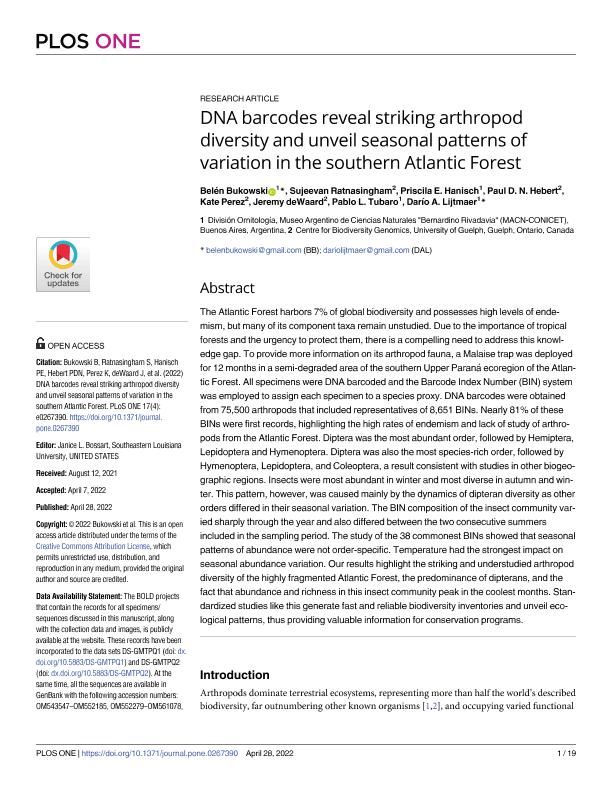Mostrar el registro sencillo del ítem
dc.contributor.author
Bukowski Loináz, María Belén

dc.contributor.author
Ratnasingham, Sujeevan
dc.contributor.author
Hanisch, Priscila Elena

dc.contributor.author
Hebert, Paul D. N.
dc.contributor.author
Perez, Kate
dc.contributor.author
deWaard, Jeremy
dc.contributor.author
Tubaro, Pablo Luis

dc.contributor.author
Lijtmaer, Dario Alejandro

dc.date.available
2023-10-10T17:27:48Z
dc.date.issued
2022-04
dc.identifier.citation
Bukowski Loináz, María Belén; Ratnasingham, Sujeevan; Hanisch, Priscila Elena; Hebert, Paul D. N.; Perez, Kate; et al.; DNA barcodes reveal striking arthropod diversity and unveil seasonal patterns of variation in the southern Atlantic Forest; Public Library of Science; Plos One; 17; 4; 4-2022; 1-19
dc.identifier.issn
1932-6203
dc.identifier.uri
http://hdl.handle.net/11336/214726
dc.description.abstract
The Atlantic Forest harbors 7% of global biodiversity and possesses high levels of endemism, but many of its component taxa remain unstudied. Due to the importance of tropical forests and the urgency to protect them, there is a compelling need to address this knowledge gap. To provide more information on its arthropod fauna, a Malaise trap was deployed for 12 months in a semi-degraded area of the southern Upper Paraná ecoregion of the Atlantic Forest. All specimens were DNA barcoded and the Barcode Index Number (BIN) system was employed to assign each specimen to a species proxy. DNA barcodes were obtained from 75,500 arthropods that included representatives of 8,651 BINs. Nearly 81% of these BINs were first records, highlighting the high rates of endemism and lack of study of arthropods from the Atlantic Forest. Diptera was the most abundant order, followed by Hemiptera, Lepidoptera and Hymenoptera. Diptera was also the most species-rich order, followed by Hymenoptera, Lepidoptera, and Coleoptera, a result consistent with studies in other biogeographic regions. Insects were most abundant in winter and most diverse in autumn and winter. This pattern, however, was caused mainly by the dynamics of dipteran diversity as other orders differed in their seasonal variation. The BIN composition of the insect community varied sharply through the year and also differed between the two consecutive summers included in the sampling period. The study of the 38 commonest BINs showed that seasonal patterns of abundance were not order-specific. Temperature had the strongest impact on seasonal abundance variation. Our results highlight the striking and understudied arthropod diversity of the highly fragmented Atlantic Forest, the predominance of dipterans, and the fact that abundance and richness in this insect community peak in the coolest months. Standardized studies like this generate fast and reliable biodiversity inventories and unveil ecological patterns, thus providing valuable information for conservation programs.
dc.format
application/pdf
dc.language.iso
eng
dc.publisher
Public Library of Science

dc.rights
info:eu-repo/semantics/openAccess
dc.rights.uri
https://creativecommons.org/licenses/by-nc-sa/2.5/ar/
dc.subject
ATLANTIC FOREST
dc.subject
DNA BARCODES
dc.subject
MALAISE TRAP
dc.subject
ARTHROPOD DIVERSITY
dc.subject.classification
Ecología

dc.subject.classification
Ciencias Biológicas

dc.subject.classification
CIENCIAS NATURALES Y EXACTAS

dc.title
DNA barcodes reveal striking arthropod diversity and unveil seasonal patterns of variation in the southern Atlantic Forest
dc.type
info:eu-repo/semantics/article
dc.type
info:ar-repo/semantics/artículo
dc.type
info:eu-repo/semantics/publishedVersion
dc.date.updated
2023-10-09T10:36:56Z
dc.journal.volume
17
dc.journal.number
4
dc.journal.pagination
1-19
dc.journal.pais
Estados Unidos

dc.journal.ciudad
San Francisco
dc.description.fil
Fil: Bukowski Loináz, María Belén. Consejo Nacional de Investigaciones Científicas y Técnicas. Oficina de Coordinación Administrativa Parque Centenario. Museo Argentino de Ciencias Naturales "Bernardino Rivadavia"; Argentina
dc.description.fil
Fil: Ratnasingham, Sujeevan. University of Guelph; Canadá
dc.description.fil
Fil: Hanisch, Priscila Elena. Consejo Nacional de Investigaciones Científicas y Técnicas. Oficina de Coordinación Administrativa Parque Centenario. Museo Argentino de Ciencias Naturales "Bernardino Rivadavia"; Argentina
dc.description.fil
Fil: Hebert, Paul D. N.. University of Guelph; Canadá
dc.description.fil
Fil: Perez, Kate. University of Guelph; Canadá
dc.description.fil
Fil: deWaard, Jeremy. University of Guelph; Canadá
dc.description.fil
Fil: Tubaro, Pablo Luis. Consejo Nacional de Investigaciones Científicas y Técnicas. Oficina de Coordinación Administrativa Parque Centenario. Museo Argentino de Ciencias Naturales "Bernardino Rivadavia"; Argentina
dc.description.fil
Fil: Lijtmaer, Dario Alejandro. Consejo Nacional de Investigaciones Científicas y Técnicas. Oficina de Coordinación Administrativa Parque Centenario. Museo Argentino de Ciencias Naturales "Bernardino Rivadavia"; Argentina
dc.journal.title
Plos One

dc.relation.alternativeid
info:eu-repo/semantics/altIdentifier/url/https://dx.plos.org/10.1371/journal.pone.0267390
dc.relation.alternativeid
info:eu-repo/semantics/altIdentifier/doi/http://dx.doi.org/10.1371/journal.pone.0267390
Archivos asociados
